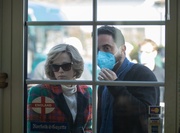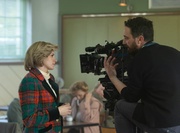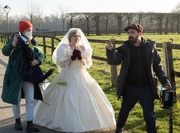I’m an outsider to the UK and an outsider to the royal family,” says Pablo Larraín. “But I don’t think I’m an outsider to Diana.” The Chilean filmmaker is making his case for why he wanted to make a film about the Princess of Wales, the forthcoming biopic Spencer. Diana was a “world icon”, he says, and he was taken with the story that she was an “incredible, mysterious woman, trapped in the wheels of history and tradition”.
He was just the director, he felt, to explore the enigma – and perhaps too her familiarity. “Even though she was born to privilege, and she eventually became Princess Diana, she was someone that felt very ordinary. Someone that you could relate to. That’s one of the mysteries – how was she able to create that amount of empathy?”
Whatever your take on the royal family, it is impossible not to empathise with Diana as imagined in Spencer, the 45-year-old’s unprecedentedly visceral exploration of the woman behind the image. Taking a loosely factual (but, one might argue, emotionally honest) approach to history, the film looks at Diana through the lens of a nightmarish Christmas sojourn at the Queen’s Sandringham House, when her marriage to Charles was on the precipice of collapse. “It’s the story of the broken princess,” says Larraín, sipping tea while sitting across a small table in a Soho hotel suite. “She gets into a fairytale, and that fairytale is turned upside down the moment she decides not to be part of the family.”
There are many aspects of Spencer that might peeve purists, not least the decision to cast Kristen Stewart, an American, in the lead role. And also because the film is quietly scathing of the royal family as an institution. In Stewart’s Diana, we see a woman on the verge of a breakdown (Larraín says she is “like a Greek tragic character”), hounded by the media and smothered by the cold austerity of “the firm”. We see her fight with bulimia re-enacted in horrible detail. We see acts of self-harm that are painful, even shocking to watch. Nonetheless, Larraín says that the film wasn’t meant to be provocative. “I’m not chasing controversy,” he says. “I’m just trying to chase something that feels real.”
He continues: “I think the movie does a proper depiction of Diana’s internal distress. And that’s what I care about. An eating disorder is never just an eating disorder. It’s a consequence of a mental health problem. It’s a consequence of an internal crisis that she’s going through. It’s important to me, if you’re going to show that someone is harming themselves, hurting themselves, you want to know, why is that happening and how. But controversy, it’s completely irrelevant. It’s not a real human concept.”
Larraín has previous in unusual studies of well-known people, no one film the same but all striking in their visual elegance. Two of his last three films have also been biopics – wildly unconventional ones at that. To English-speaking audiences his most well-known film is Jackie, the 2016 drama that starred Natalie Portman as JFK’s shell-shocked widow. That same year he released playful cat-and-mouse drama Neruda, starring Luis Gnecco as fugitive poet Pablo Neruda and Gael García Bernal as a fictional police investigator on his trail. After that, Larraín returned to his roots with the low-budget, exhilaratingly kinetic 2019 Chilean drama Ema, before hitting biopic mode again. What prompted him to choose Diana as his next subject? For one thing, he tells me, his mother.
“She was the first person that I saw as I grew up, who I was really interested in,” he explains. “When the tragedy happened in 1997 and Diana died, my mum was really sad. Later I realised that she was just one out of hundreds of millions around the world. And I became very curious. Why? Why does this person, who was a princess in the UK, have such an impact on my mother’s life? After an extensive research process that included movies, TV shows, articles and books, I knew less and less. The more I learned, the more mysterious she became to me, the fewer answers I could find. And that mystery is essential to cinema, I think.”
Timeliness is perhaps essential, too. One of the key themes in Spencer is escape – from a ruined marriage but also from the suffocating, impersonal ritualism of the royal family. It’s all too tempting to relate Spencer’s depiction of the royals to Prince Harry and Meghan Markle’s situation, and their decision to break with royal tradition and flee to the US, although it does feel eerily prescient. Spencer was still midway through filming when the couple’s bombshell interview with Oprah Winfrey aired earlier this year. But Larraín insists any parallels were not deliberate.
“It’s not the intention that we had when we did the movie,” he says. “But we look at reality from where we’re standing. From the present. So of course people will relate it to whatever’s happening right now, and whatever is going to happen tomorrow, yesterday. But I would be very specific and clear, that it’s not the reason that we did it. And we weren’t specifically chasing it. But I don’t think it’s avoidable.”
Larraín has never shied away from politics before; his early films, including the wonderful Oscar-nominated 2012 drama No, delivered pointed criticisms of Pinochet’s dictatorship. Spencer is a less overtly political work, though it still condemns the royal establishment in its scenes of queasy wealth and excess, and in the toll it takes on Diana. What is framed as well-meaning concern – sewing Diana’s curtains shut to prevent paparazzi from seeing through her window, for example – reads ultimately as oppression rather than protection. In any case, Larraín seems happy to let the film speak for itself. “Whatever I think about the current situation of the royal family, I deeply and honestly think [my opinion is] irrelevant. Who would possibly care what I think? I will say that I have enormous respect for both William and Harry. And I think they have gone through a lot of difficult times.” It’s Charles that, somewhat predictably, gets short shrift in the film – played with buttoned-down frustration by Poldark’s Jack Farthing – while Camilla is nowhere to be seen.
The remaining cast is not as starry as Stewart but populated with recognisable faces: Timothy Spall plays a hard-nosed equerry; Sean Harris the house chef; Sally Hawkins plays the royal dresser and Diana’s sole adult confidant. It is these parts that offer small telling insights into the below-surface operations of the royals, while Charles and the Queen (portrayed by Stella Gonet) are confined to small roles in the narrative.
Larraín is unbothered by any criticism that his cast, especially Stewart, aren’t the spitting image of the royals themselves. “When movies are portraying real people and all they care about is how similar the actors look to the real people, you are in danger of getting into a lookalike contest,” he muses. “You might win! But it could end up being distracting for everyone involved. And what is really beautiful is when someone like Kristen, who is American, can travel towards the character and deliver something that is completely believable.”
Larraín is effusive in his praise for his lead actor, whom he describes as “like an old-school movie star in the best sense – like those actresses from the Fifties or the Sixties”. Recalling their time on set, Larraín says he didn’t end up directing Stewart in the “regular, conventional way”. He continues: “There was a point that she had such a control of the character, she was so into it so deep… I discovered that on many occasions my best instruction was no instruction. Just stay silent and film her. I wish I would’ve known it before, honestly. You understand your own limitations as a man when you’re portraying a female character.”
Stewart herself has spoken about the role in spiritual terms; it was by all accounts an unusually intense undertaking. She has said that she would break down regularly over the “lacerating” remembrance of Diana’s death and described having “spooky, spiritual feelings” on set. “There were moments where my body and mind would forget she was dead,” she told the LA Times. Larraín doesn’t go quite so far, but when talk turns to the star’s performance, his tone is one of awed reverence. Was he aware of just what Stewart was going through? “It’s not that you were more or less aware. I saw it. It was just happening in front of me.
“There’s a point on a process like this where there’s an actress, Kristen, and then you’re on a set, and then it’s make-up, and then there’s another actor, and then there’s more make-up, more things, and then there’s props; lights; a microphone. The mechanics of a production. But there’s a point, where you see something that has a cosmic truth. On a monitor. And you look up from the monitor, and you see her, and you say, ‘this is what it is’. She’s not impersonating her, she’s not just playing her. That’s not acting. It’s something else.
“And that is incredible, when that happens. It’s a f***ing miracle.”




No comments:
Post a Comment
What do you think of this?